Coming into the competition as one of the favourites to win it, Brazil’s first match in the 2022 World Cup was long awaited. Their first challenge in the search for the historic Hexa was Serbia, a tough opponent led by Dragan Stojković.
Although this Serbian generation is a special one, Brazil were fortunate as Juventus’ stars Dušan Vlahović and Filip Kostić were unfit to start the match.
Nonetheless, the Europeans assembled a competitive and relentless side with the goal of upsetting the South American giants.
From the very beginning of the match, it was clear overcoming this Serbian side would be far from easy.
Contrary to many people’s expectations, Stojković’s men were aggressive and intense without the ball.
The 57-year-old manager introduced a solid defensive strategy to keep the Seleção from imposing themselves.
On the other end, Tite’s men were incredibly sound defensively, keeping Serbia from creating any real danger.
With time, however, Brazil began to control the match and break down Serbia’s tight defensive structure.
Tottenham’s Richarlison was the man of the hour, scoring the only two goals of the match. Chelsea’s Thiago Silva and Man United’s Casemiro were also unsung heroes in Brazil’s first win of the competition.
At any rate, this victory confirmed Brazil’s chances to bring the trophy back to South America, but most importantly, it showed the resilience and security Tite’s men have when facing aggressive opponents.
In this tactical analysis, we will examine the tactics behind Brazil’s 2-0 victory over Serbia.
In addition to exploring and identifying how Stojković’s defensive system caused Brazil trouble, this analysis will also look at how Brazil were able to assume control of the match and find the answers to Serbia’s puzzle.
Finally, we will also look at Brazil’s incredibly secure defensive system.
Lineups
Throughout this first week, the noise around Brazil’s camp was how attacking Tite’s line-up in the opening match was rumoured to be. O Globo, a famous newspaper in Brazil, regularly tends to report the Seleção’s starting XI a few days before their matches. This time was no different, and with such an attacking line-up, there was a lot of talk about how this side would actually play in the game.
With Alisson in goal, the backline did not have any surprises with Danilo, Marquinhos, Thiago Silva, and Alex Sandro making up a back four. In the midfield, however, there was a significant change. Casemiro was the only true midfielder in the eleven, with Neymar and Lucas Paquetá being the more advanced players ahead of him. The front three consisted of Vini Jr., Richarlison, and Raphinha. With the absence of a second midfielder such as Fred or Bruno Guimarães, there was a lot of talk regarding the variations and adaptations Tite would make.
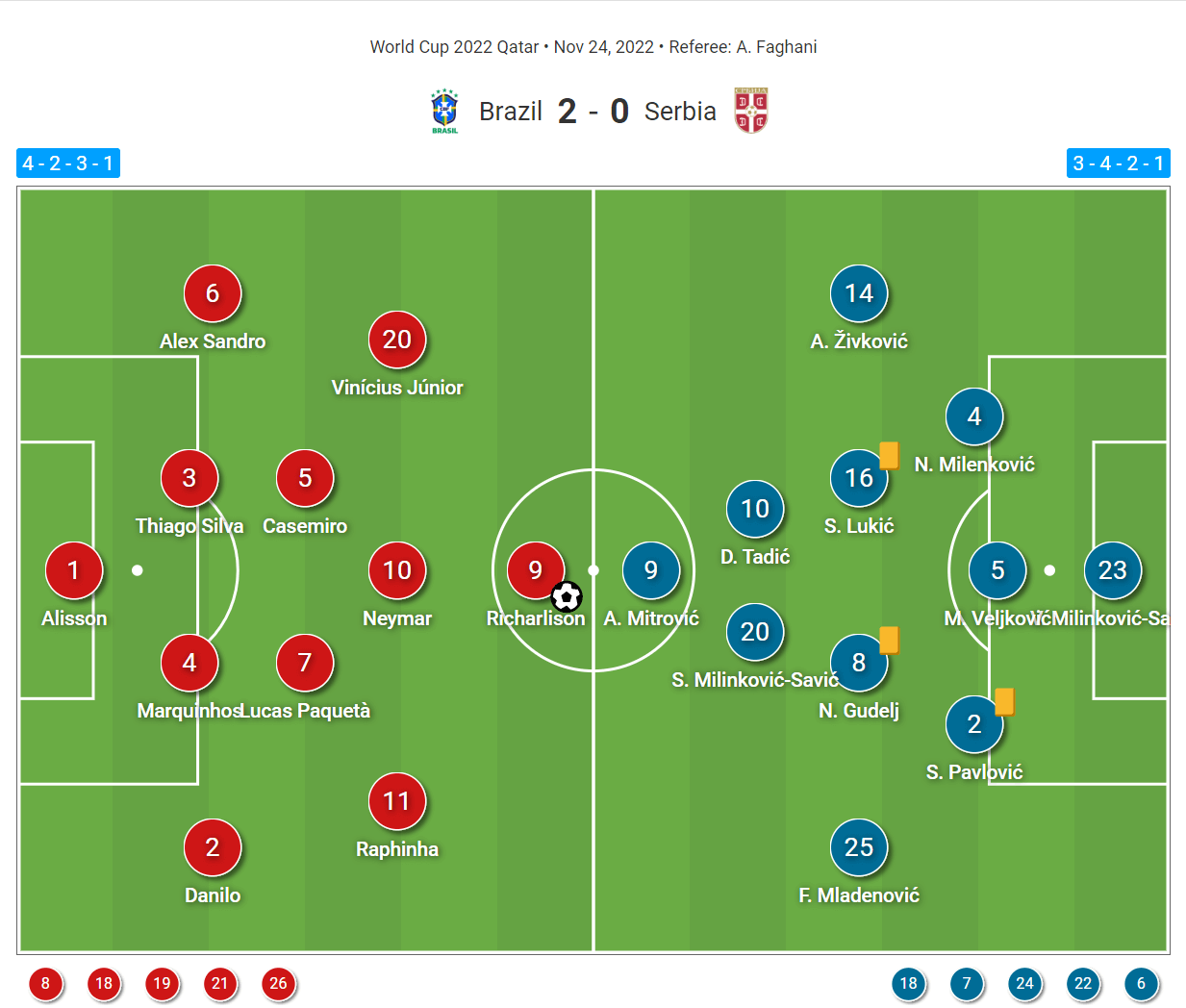
For Serbia, without Dušan Vlahović, Stojković lined them up in a 3-4-2-1 formation. However, in the game, it actually became a 3-4-1-2 with Dušan Tadić joining Aleksandar Mitrović up top. The back three consisted of Nikola Milenković, Miloš Veljković, and Strahinja Pavlović. The wing-backs were Andrija Živković and Filip Mladenović, while Saša Lukić and Nemanja Gudelj formed a double pivot. Lazio’s Sergej Milinković-Savić was the number 10, and Tadić and Mitrović were the two centre-forwards.
Stojković’s plan
Serbia displayed a surprising defensive aggressiveness from the very beginning. Stojković refused to allow Brazil to assume control of the match, and with such an intense system, they made life extremely frustrating for the Seleção in the first half. Although they had 60% possession in the first 45, Tite’s men only managed a total of four shots. Serbia allowed next to no time on the ball for the Brazilian players, making it extremely difficult for them to ensure the control they desire.
This defensive system began with a surprising high block. The Serbian players wanted to disrupt Brazil’s possession in its early stages, and they looked to do so with a man-marking system. The first line of pressure was obviously led by the two centre-forwards, who looked to jump on Brazil’s centre-backs. Both wing-backs advanced extremely high to mark Tite’s fullbacks, and in the middle, each player had determined roles. Milinković-Savić was tasked with following Casemiro, and behind him, Gudelj was on Paquetá while Lukić had the difficult task of stopping Neymar.
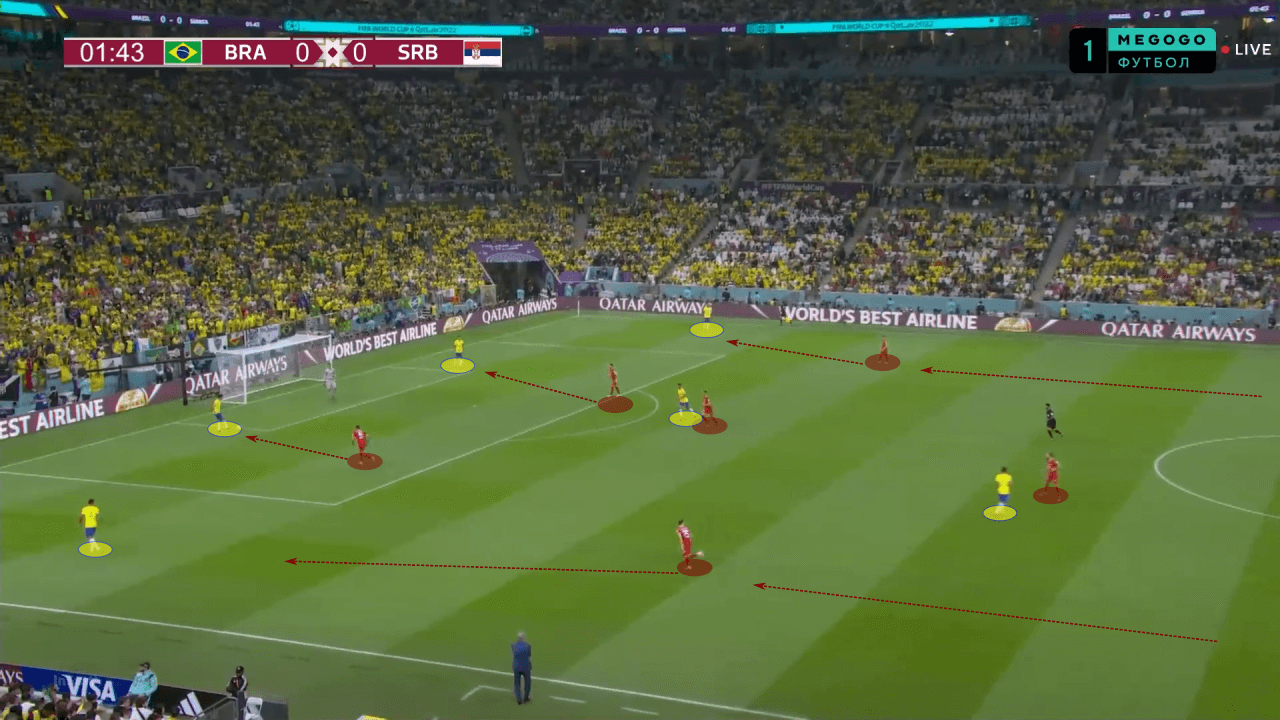
As Brazil picked a side, Serbia’s players would naturally follow the Brazilian players over and shift their block. In the image below, it can be seen how strictly they adhere to this man-marking model. Although this was an extremely aggressive system, it made life in possession extremely difficult for Brazil.
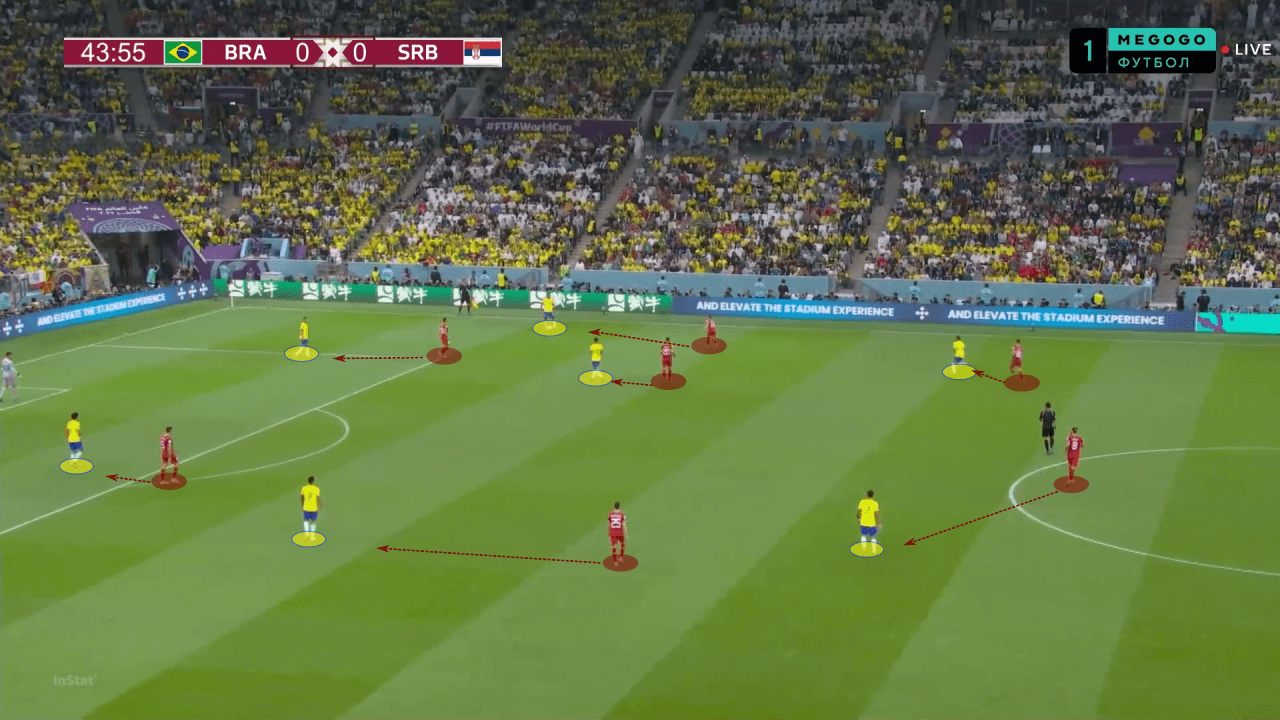
As the half went on, Brazil’s advanced midfielders, Paquetá and Neymar, began to drop deeper more often to get on the ball and create numerical superiority. However, this only attracted more Serbian players and made the pitch more congested. In the instance below, Serbia commit six players in Brazil’s third to pressure their build-up.
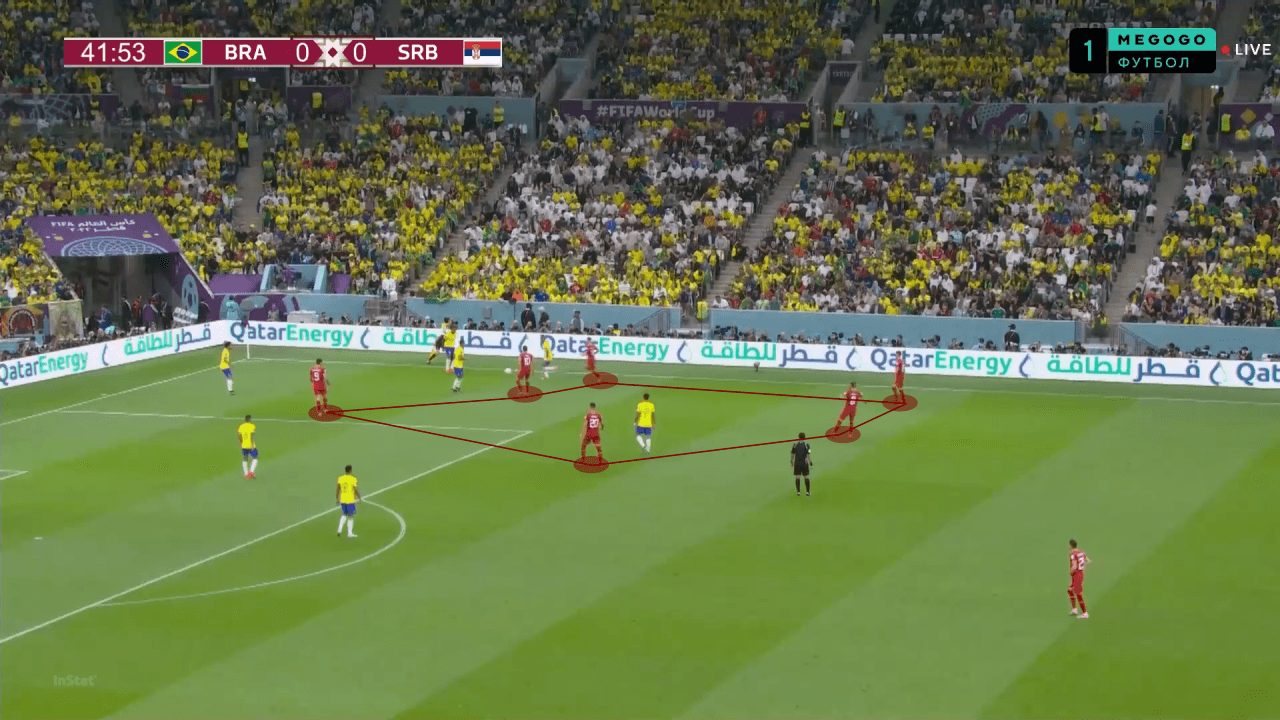
In lower blocks, a similar system was maintained, except with a few more rotations. Brazil’s positional attacks involved significant positional rotations, free roaming from Neymar and Paquetá, and overall heavy manipulation. In an effort to remain secure and limit the space, the Serbian players began switching roles depending on Brazil’s movement. In the instance below, although Lukić was originally tasked with Neymar, he jumps on Alex Sandro as he receives a pass from Thiago Silva. Milenković, the right centre-back, is then tasked with stepping up to mark Ney. At any rate, the intensity and limiting of space were still maintained in lower blocks.
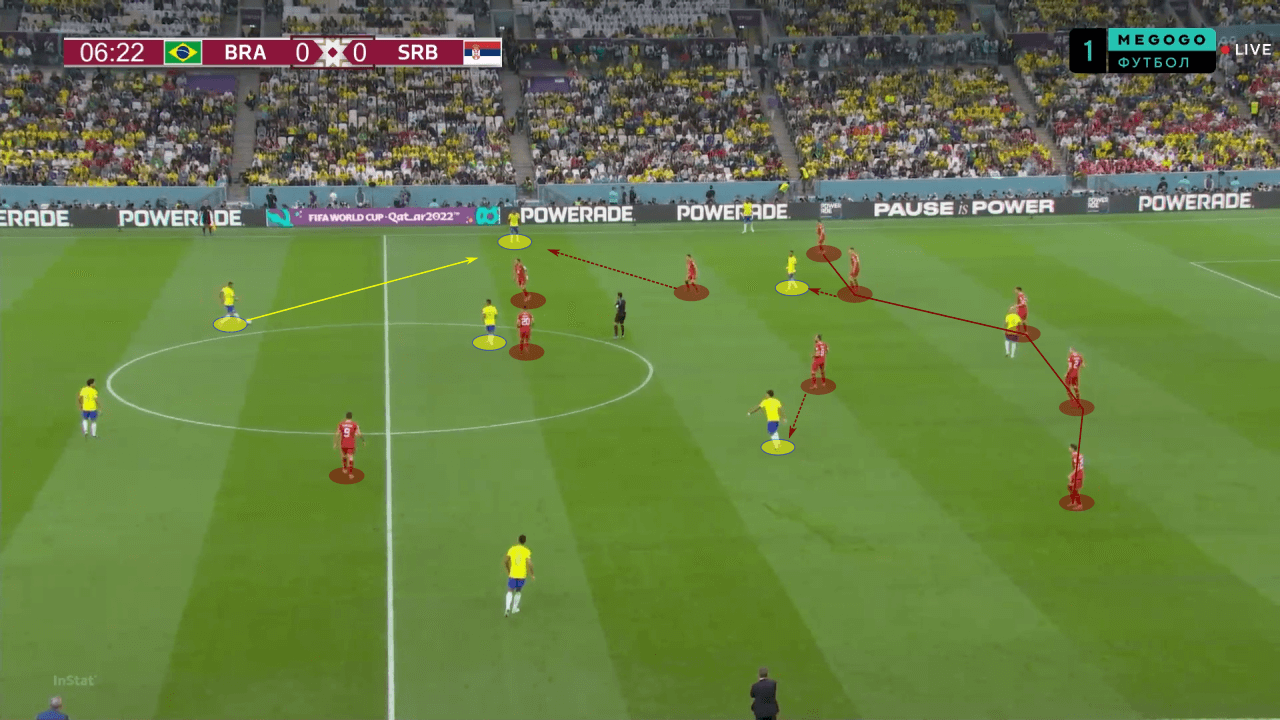
Stojković’s defensive strategy resulted in a frustrating first half for Brazil, with the South Americans struggling to create any real opportunities. It not only kept them from reaching the final third effectively, but it also limited the control they had over their possession and the overall game. However, as the match went on, Brazil began to find answers.
Brazil’s solutions
As mentioned, there was a lot of talk about how Brazil would actually structure in possession with such an attacking starting XI. Since the 2018 World Cup, Tite has strictly adhered to the Positional Play model, and with such, he constantly switches between a 3-2-5 and a 2-3-5 in possession. Similar to Pep Guardiola’s Man City, this is often created with the fullbacks.
Both Danilo and Alex Sandro are extremely versatile players, with the former now playing as a centre-back for Juventus. With such characteristics, Tite has a lot of freedom when choosing his line-up, as he can count on his fullbacks to perform a variety of roles.
In this match, Casemiro was the only deep-lying midfielder. Consequently, in possession, both fullbacks would drift inside and sit alongside the Man United player to form a 2-3-5. They most frequently sat on the half-spaces and supported play both centrally and wide. The line of five was created with both wingers remaining wide and Paquetá and Neymar occupying the half-spaces.
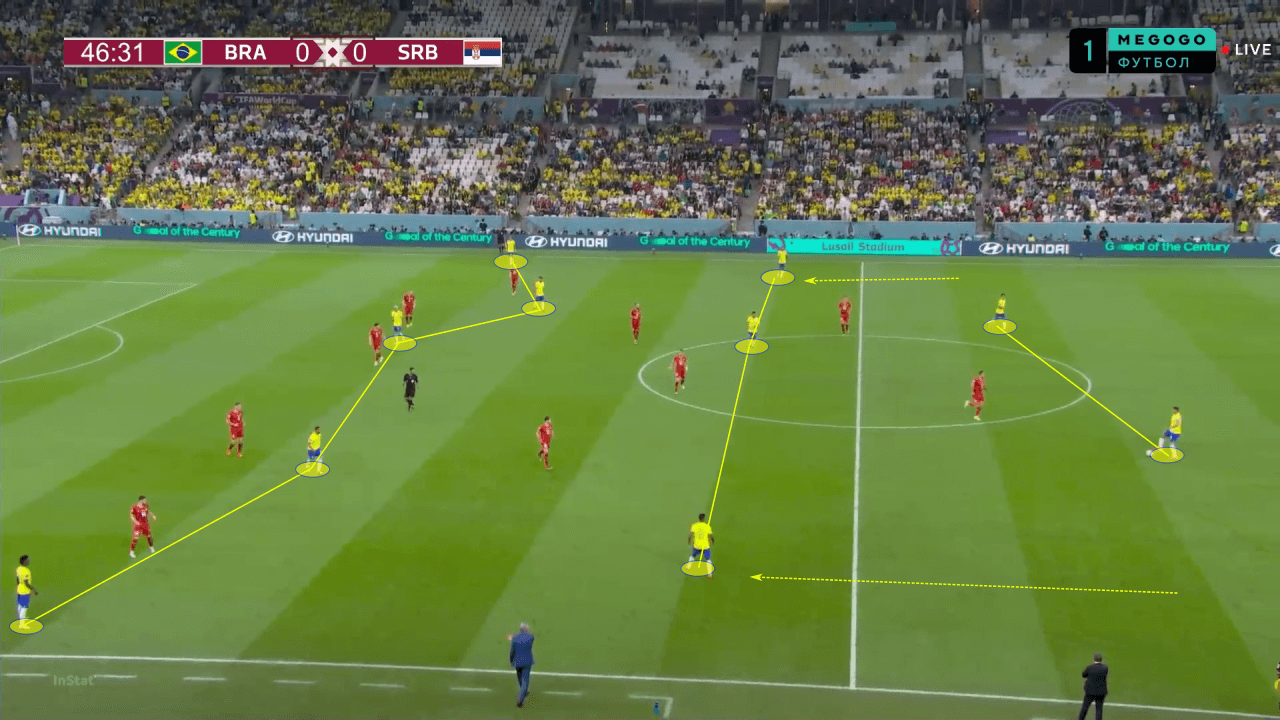
The creative duo had a lot of positional freedom though. Often roaming in between the midfield three and the front three, they were pulling all the strings in Brazil’s attacks. The duo consistently found spaces in between lines to receive the ball and connect the midfield with the attack.
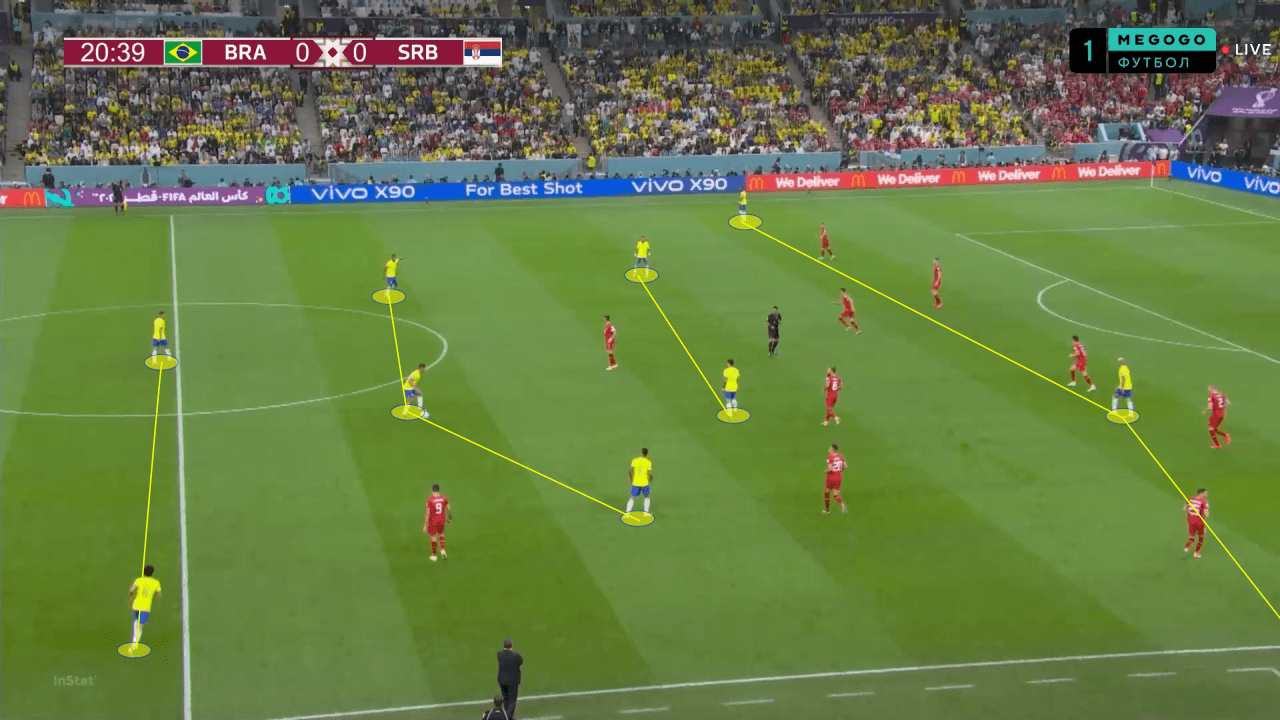
The two attacking midfielders worked in combination with the inverted fullbacks to create through the central channels. With a total of five players occupying the midfield, Brazil often had numerical superiority centrally. With such, they were constantly able to manipulate Serbia’s defensive organisation and create space. In the instance below, for example, Lukić drifts wider to mark Alex Sandro, leaving a hole in between the lines for Neymar to receive.
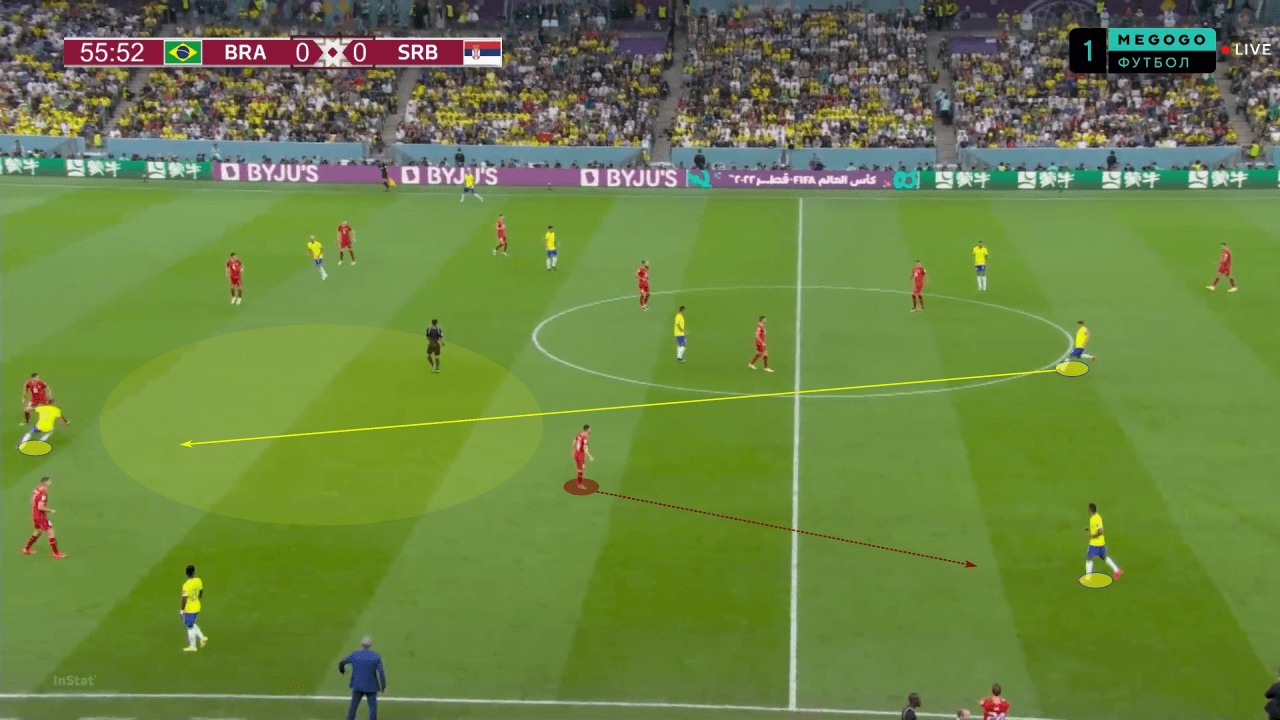
Their relentless movement off the ball often became too much for Serbia’s defenders to handle. The advanced duo were constantly moving into spaces and attacking channels. In the example below, Raphinha remains as wide as possible to stretch Serbia’s backline. By doing so, he creates a channel for Paquetá to run into. After Raphinha receives it from Casemiro, he quickly plays Paquetá in behind.
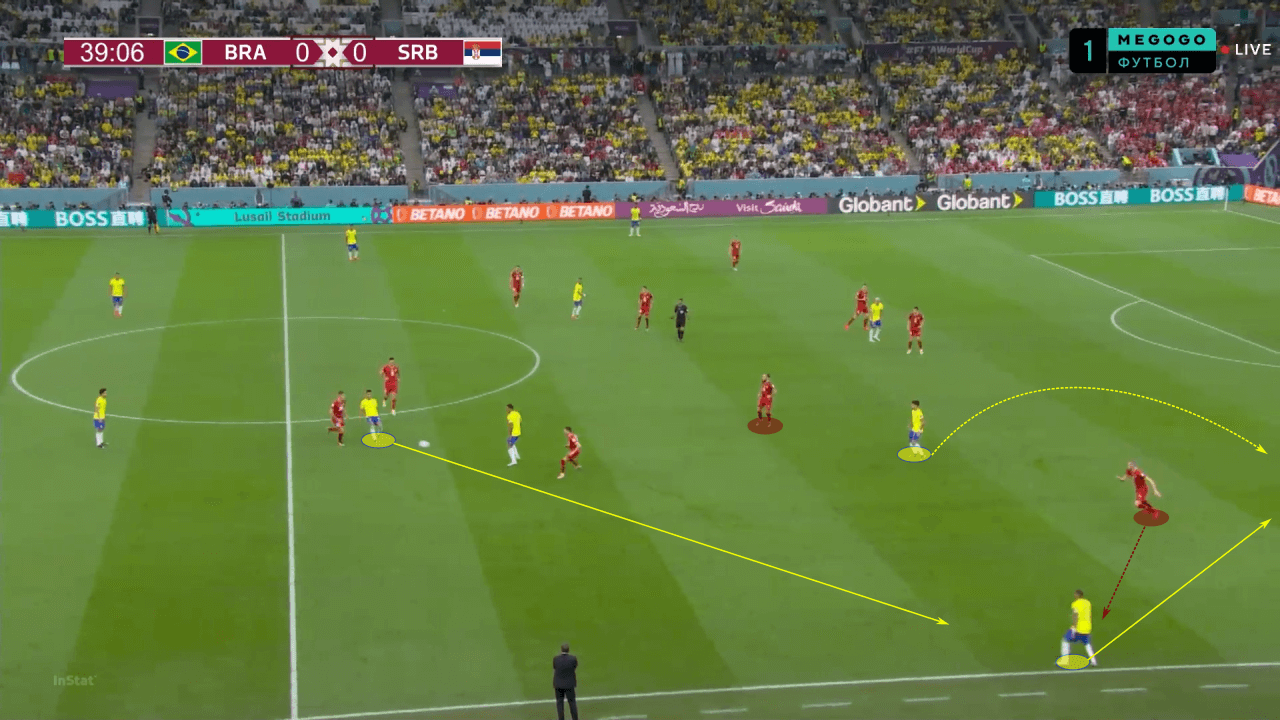
Sometimes, Paquetá would roam all the way to the opposite side. Once again, he confuses Serbia’s midfield and creates a significant gap between the lines, simply by being elsewhere in the midfield. The West Ham player gets on the ball and plays Casemiro who immediately backheels it to Richarlison.
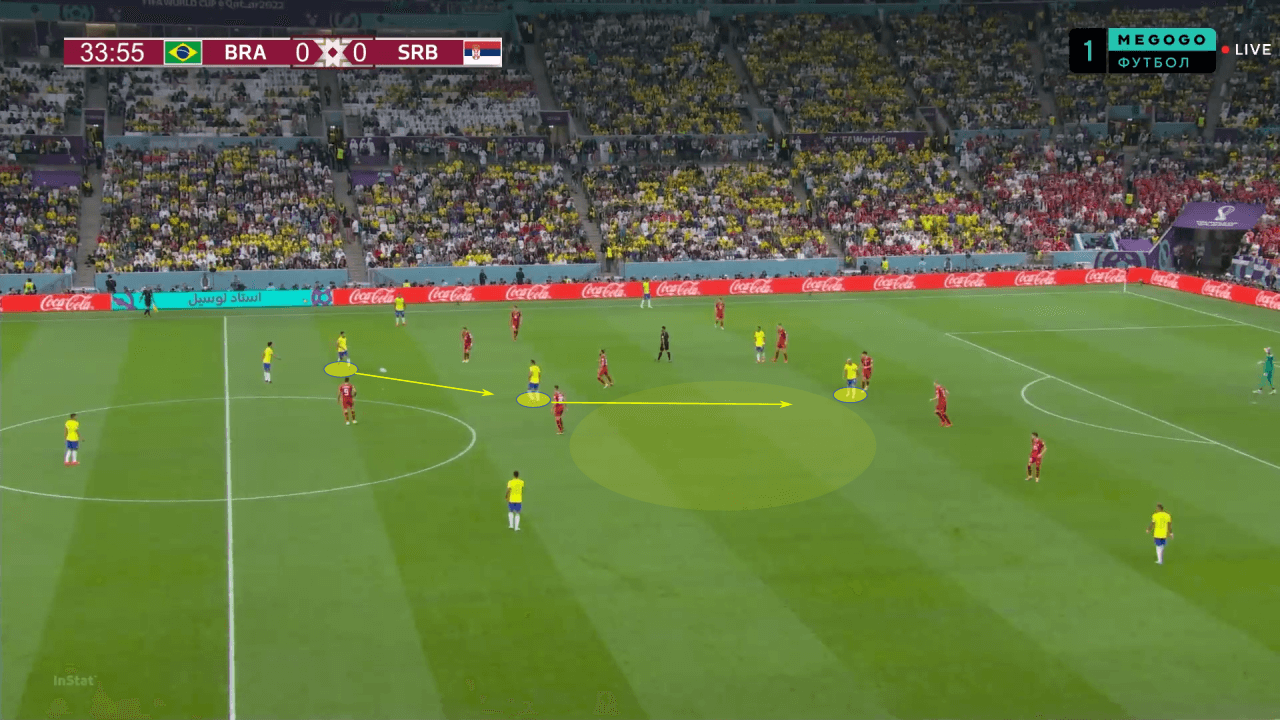
One of the main objectives of the inverted full-backs was to create 1v1 scenarios in wide channels. By leaving Vini and Raphinha isolated on the wings, they were often left alone with Serbia’s wing-backs. Considering the quality of these wingers, these scenarios are extremely favourable. This can be illustrated in the image below. As Danilo drives forward in the right half-space, he plays Raphinha wide who is 1v1 against Mladenović.
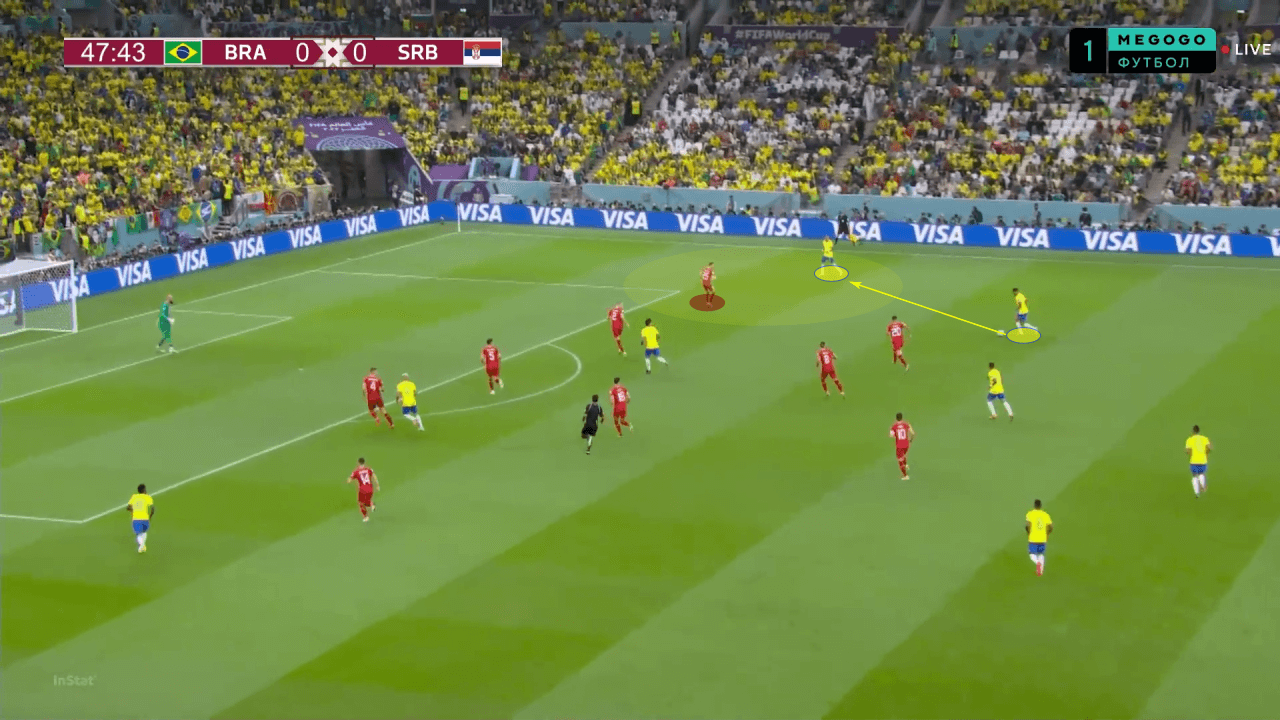
In a more drastic example, Vini is completely isolated with Živković. After concentrating their possession in the wide channel on the right, Brazil attract Serbia’s entire defensive structure over. Meanwhile, Alex Sandro significantly drifts inside. Once he receives it, he quickly finds Vini in a 1v1 on the opposite wing.
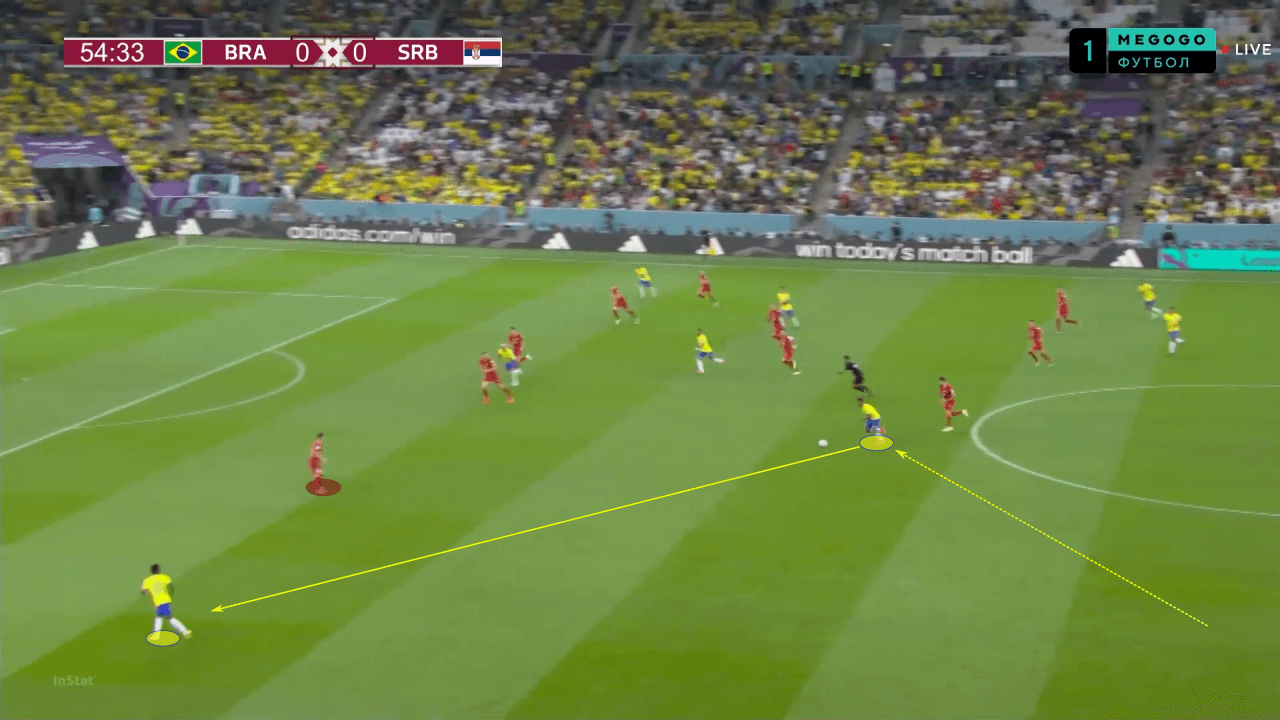
These solutions take us to Brazil’s two goals, which came after the hour mark. In the first, Casemiro is able to find Neymar in a gap inside Serbia’s low block. The superstar’s individuality allows him to get away from the defenders and reach Vini on the left, who has a first-time shot at the opposite corner. Richarlison is then able to put it in the back of the net after the keeper saves it.
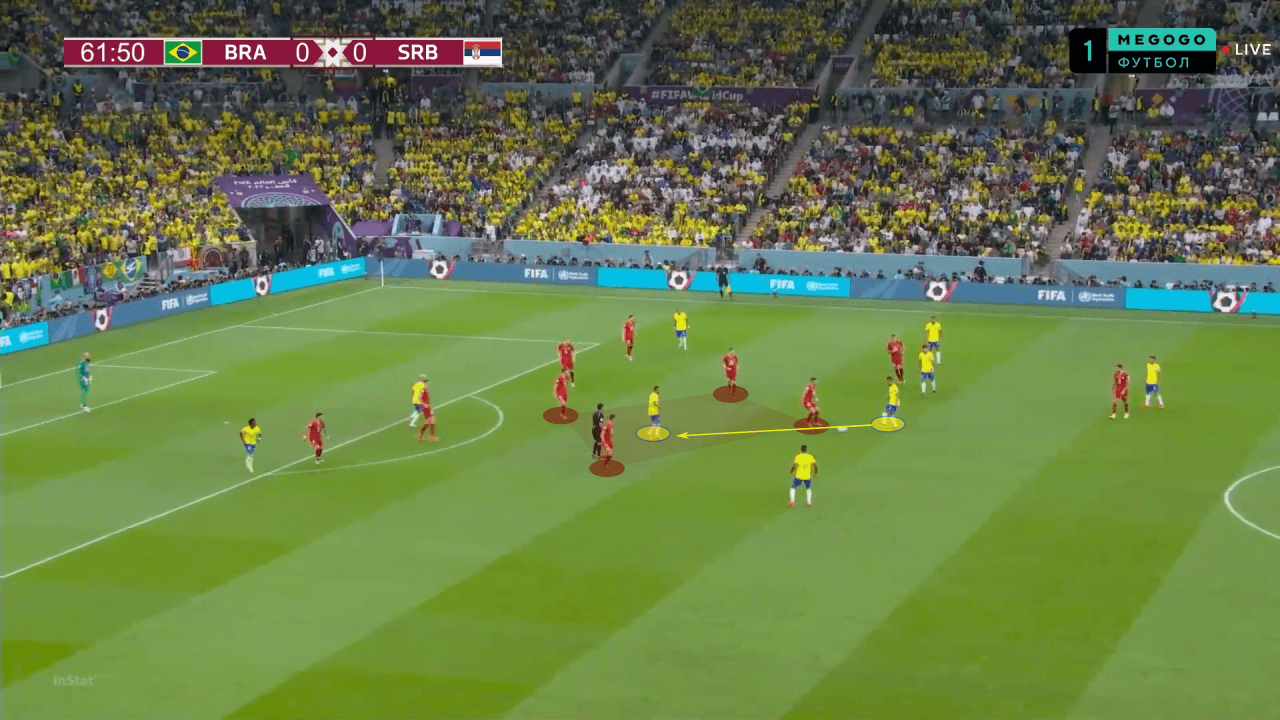
The second goal, however, is much more structured. It begins with Neymar shifting wide to join Vini on the left wing, creating a 2v2 scenario. Although they do not have numerical superiority, they certainly have qualitative superiority. After Neymar finds Vini, the Real Madrid winger takes the defender on and finds Richarlison inside the box.
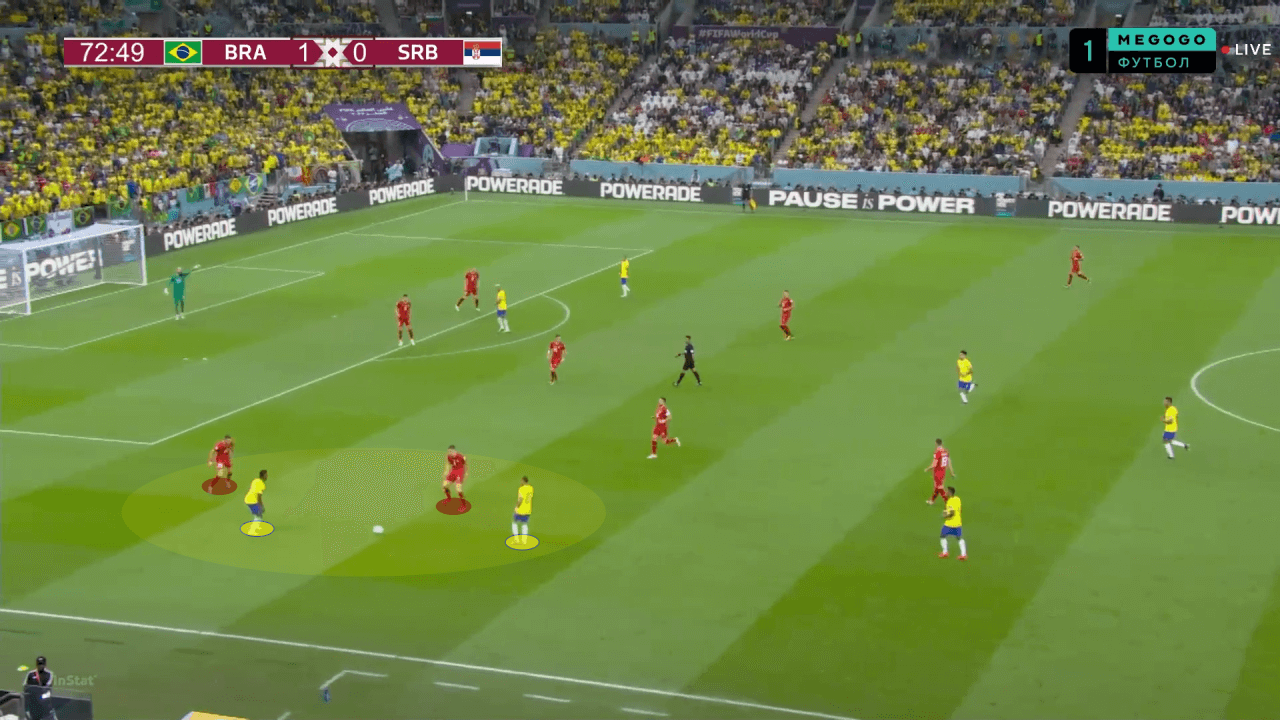
Tite’s defensive system
Coming into this tournament, as has been the case throughout history, Brazil is revered for their attacking power. However, they also have significant defensive security which often goes unnoticed. This was once again the case against Serbia. Although the Europeans challenged them defensively, they hardly posed a threat with the ball.
Tite’s Brazil are capable of a number of defensive variations, being consistent with their flexible and extremely adaptable nature. They defended the first match of the group stage in the manner they usually do – pressing extremely high. In the first half, this was done in a 4-2-4 structure, with Paquetá sitting alongside Casemiro. Neymar led the press alongside Richarlison, while Vini and Raphinha were on the wings.
After Serbia picked a side, the nearest centre-forward would jump on the centre-back while the other tucked in on Gudelj. In this zonal system, they were able to congest the pitch and overwhelm the Europeans into going long. Their final 7.74 PPDA represents how successful they were in doing so.
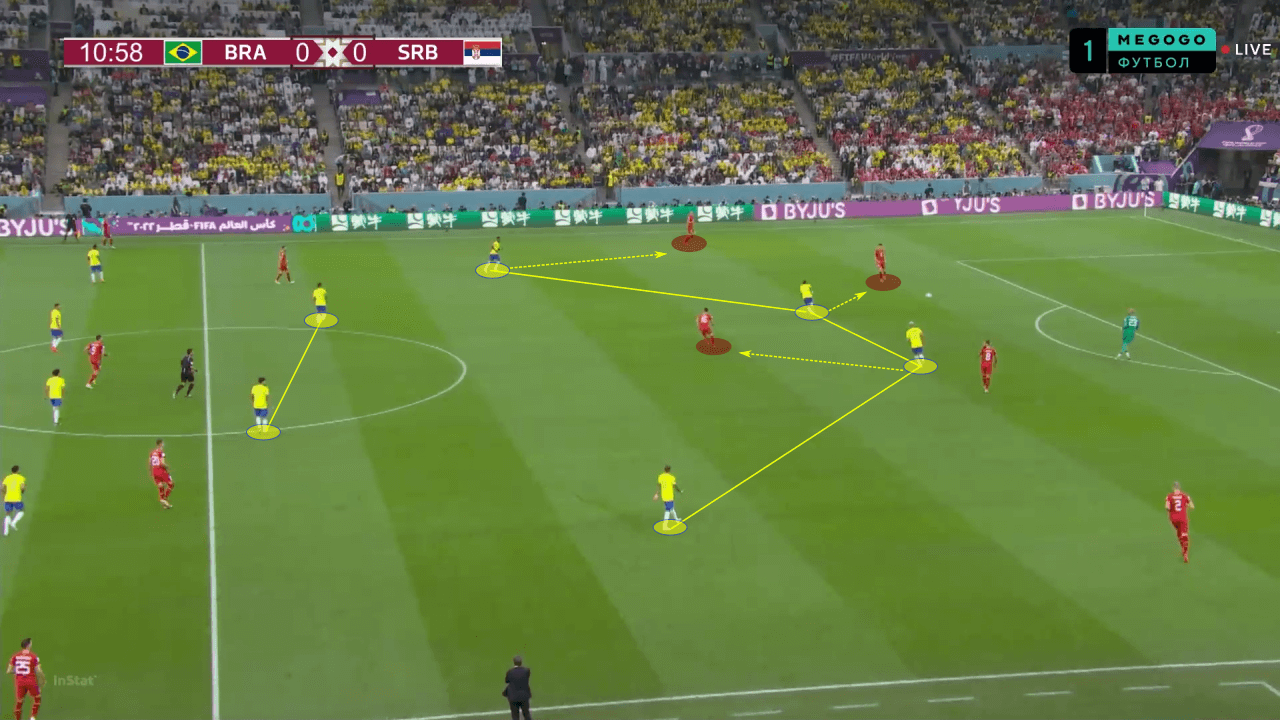
In the second half, their pressing structure changed to a 4-3-3. In this new system, the wingers were more centralised, and the front three mirrored Serbia’s back three. Neymar sat deeper while he and Paquetá marked Serbia’s double pivot. In order to cope with the wing-backs, Brazil’s fullbacks advanced higher.
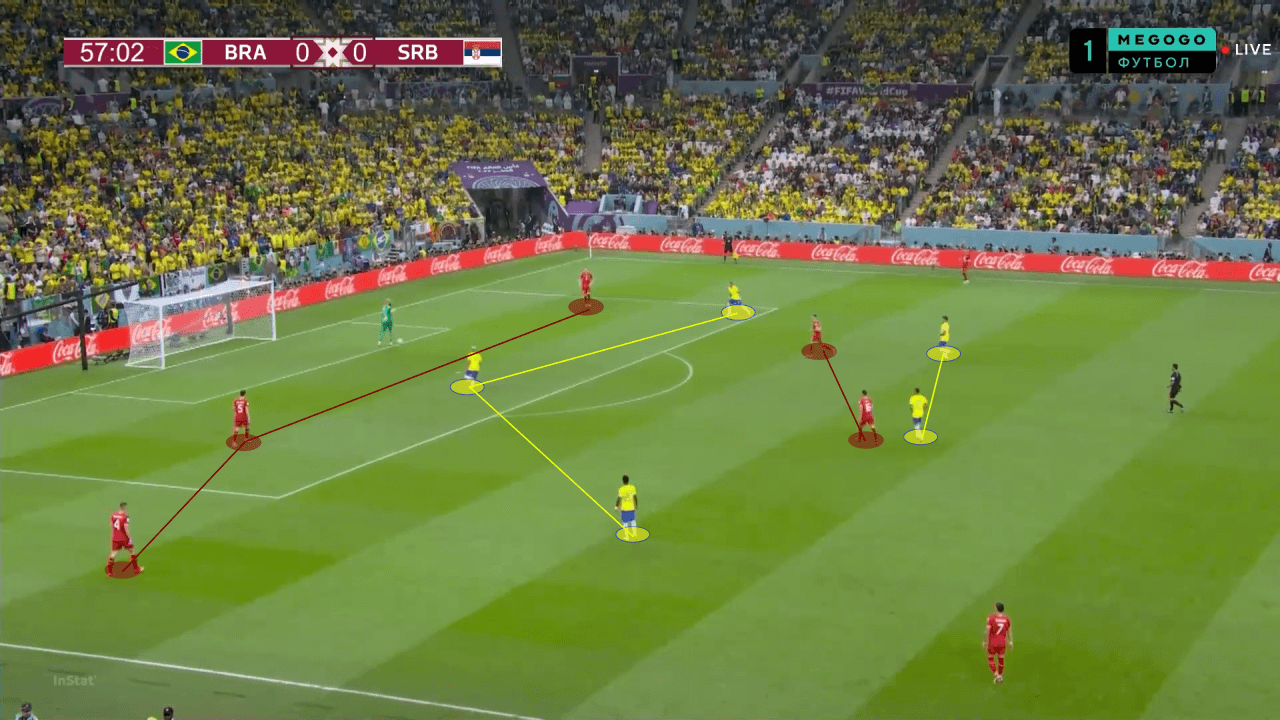
Their pressing became much more effective in the second half, but it was their defensive transitions that made the difference. Until the goal, Brazil were able to suffocate Serbia in their half for most of those 15 minutes. This was a direct result of their counter-pressing system which constantly immediately regained the ball. In the instance below, after a failed cross, Brazil immediately set up a counter-press to keep Serbia from getting out.
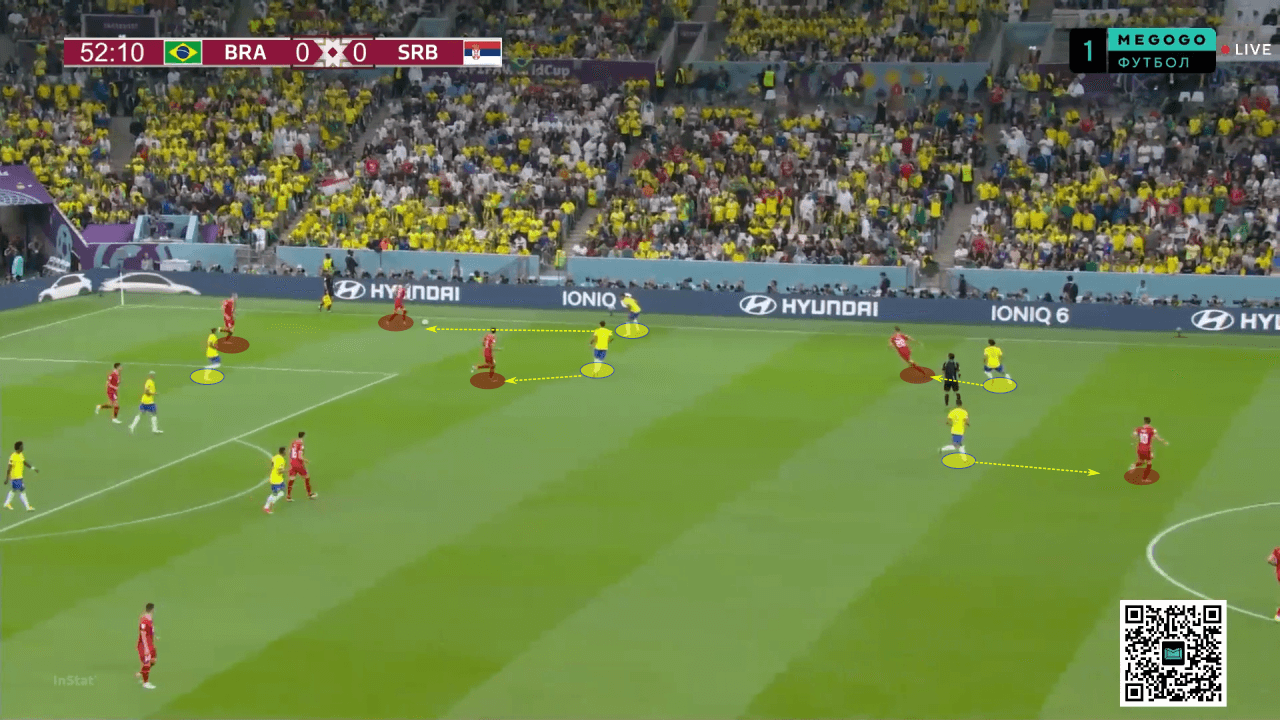
When Serbia began attacking more towards the end of the match, Brazil demonstrated their ability to defend in lower blocks. They sat in a 4-4-2 structure with minimal space between the lines. In this system, they were extremely effective in passing players on and maintaining a secure zonal structure.
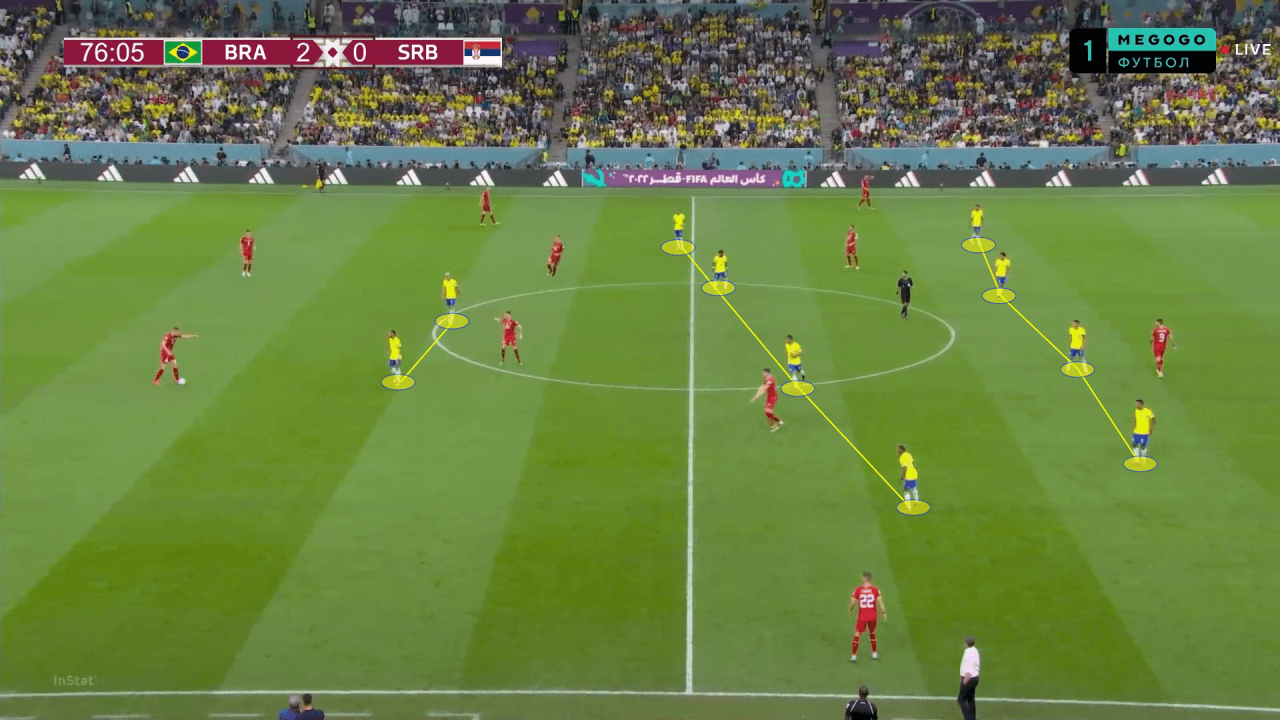
Conclusion
Brazil’s World Cup campaign got off to an extremely strong start in their 2-0 win over Serbia. The Seleção initially demonstrated great resistance to Serbia’s aggressive defensive system, and as the match went on, great resilience and creativity to break down their low block. The opponent was far from an easy one, and with such a dominant victory, Brazil’s Hexa charge is looking extremely promising.

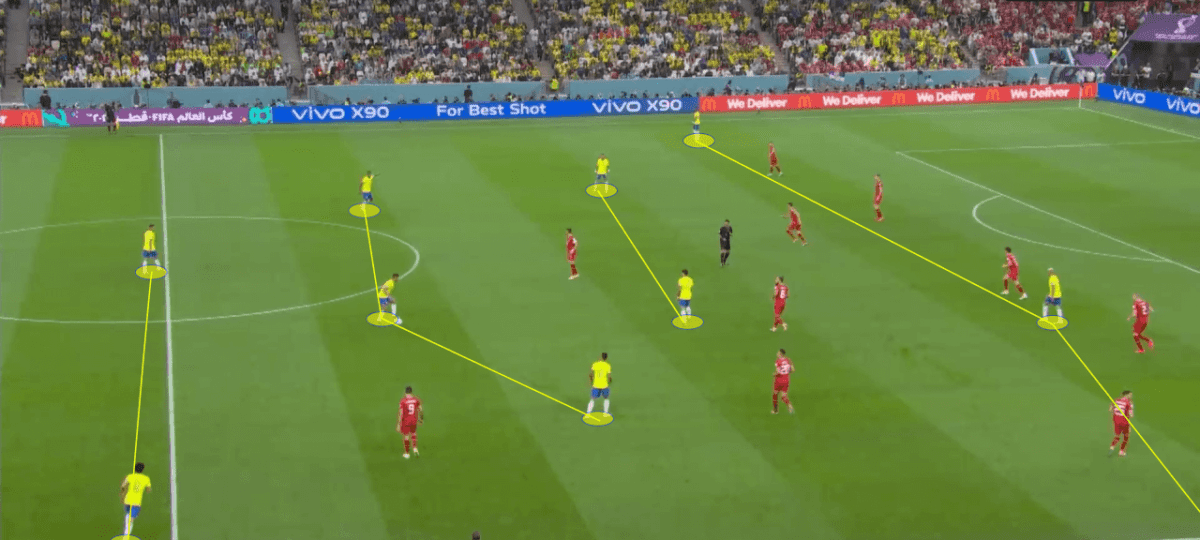



Comments